|
Islendingur
by Lew Clayman lew_clayman@yahoo.com
| Islendingur ("Icelander") is a 70' replica Viking ship which visited
New York late in October, and I visited her there. In addition, we took a zip around the
harbor, camera in hand, aboard the tourist speeder "The Beast". In honor of the
1000th anniversary of the discovery of Vinland (North America) by Leif Ericson, the ship
sailed from Iceland to Greenland to Newfoundland to Boston to NYC, where she docked at
South Street Seaport, a para-turista deal a few blocks south of the Brooklyn Bridge which,
I am assured, may be purchased at a very favorable price. One reason for visiting NY is
because Islendingur's captain has a theory that part of Leif's expedition made the trip
and stayed there for a while. |
| 1) Also, dig that crazy deckhouse. BTW, the sail is not in tatters, those are
lashings of various sorts. You are facing roughly southeast, lower Manhattan to the right,
Brooklyn across the water, and all kinds of interesting flags atop the mast. |
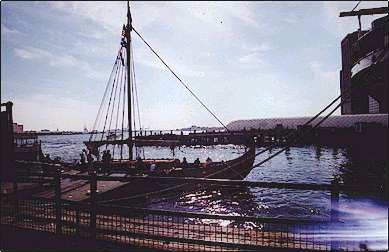 |
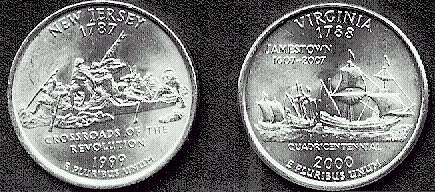
|
| 2) the backs of two commemorative US 25-cent pieces. (that's Geo
Washington and Co crossing the Delaware River by standing up in a skiff in a snowstorm on
Christmas Eve at midnight, heading for a fight in Trenton. And we worry about Bush and
Gore! On the right, Sir Walter Raleigh leads a bunch of people to a certain death
from causes which are still debated. On the plus side, they named a cigarette after him.) |

3) the sleeping quarters from the forward cabin
of Islendingur. |

4) A detail of one oarport-blocker and some nail roves. |
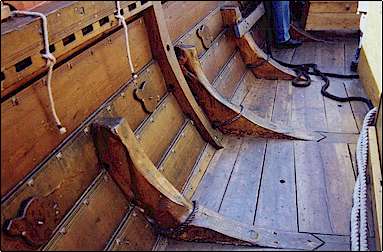
|
| 5) Looking forward along the port rail, around midships.
Barely visible to the right is the side of the plywood deckhouse. The lines hanging down
secure the faux shields to the gunwale. Note the plywood pieces through-bolted to block up
the oarports, the grown framing knees, and the lack of rowing thwarts. This
scan brings out several more details: lines lashed at the bend of the knee, pullup holes
for the false floors, and probably more I don't see or recognize. |
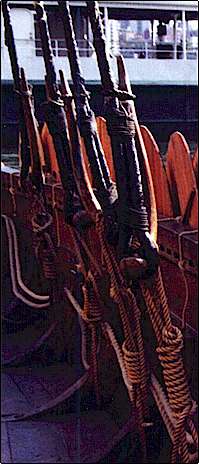
6) The faux shields are mounted only on the port side, farther from the camera. That
little tidbit will help you orient some of the other pics.
|
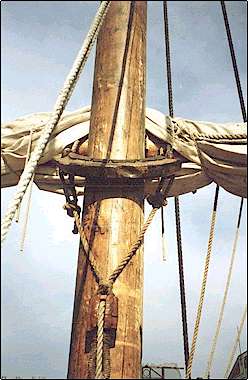
7) Q: What's tall, lanky, and wears a bolo necktie and a shirt
with sleeves but no bodice?
Hint: it has a marked Reykjavik accent. |
8) It's four pics, stitched together by PanaVue software ( https://www.panavue.com )
The deal is, it takes photos of overlapping scenes and merges them
"seamlessly" into one panoramic strip. In this case, there are four shots of the
boat, but it'll do any number. I used the free download edition, if you pay the freight it
doesn't put the logo all over your pictures.
If you're wondering about the disemodied legs on the dock near the
bottom of the picture, they come from the software guessing wrong. It got the boat
connected up pretty well, though. |
 In the picture,
you can see a little bit of the FDR Drive on the left, behind Mystery Kid's |
9) Here is are grown shroud toggle belaying pins, or
whatever the correct term is. Basically, they appear to be lengths of straight
branch or root, complete with the knotty area at the trunk (or whatever that knobby end
is). The bottom of the thing is secured to a knee via a rope arrangement which also serves
as turnbuckle, and the shroud has an eye worked into it, which is passed around the kink
and standing part is lashed to the branch end of the grown whatzit.
It might be that the ropes visible on all the knees are there to allow the shrouds to be
moved to other attachment points along the side of the hull. Clearly, these are running
rigging, since the yard is currently over the center line of the boat! I'm guessing that
the procedure is to move one at a time, leaving three to bear the load until the moving
one is secured again in the new location. Very clever, these murderous medieval
barbarians. |
10) Look closely and you'll see the engine controls, compass,
sternpost antenna, and a line of unknown (to me) purpose running from the rudderpost to
sternpost. Possibly it keeps the rudder from floating up and aft, as it might try and do
if not weighted in the modern style.
Today we're back at the midships port rail, this time looking aft. Note the lashings for
the shrouds (?) - detail photo to follow. Also, down near the floor, there is a large
timber with a large hole in it, which angles forward and inboard and does not cut all the
way through the timber. What's it for??? There is a mirror image on the starboard side, if
that helps anyone figure it out. |

|
| Re the lack of thwarts, I was flipping through a book
the other day in Barnes & Nobles (the brick and mortar kind) about the Hodding Carter
longship voyage: they stood and rowed, facing forward I think. Islendingur does not appear
to be deep enough for this, but remember: these are false floors. |

|